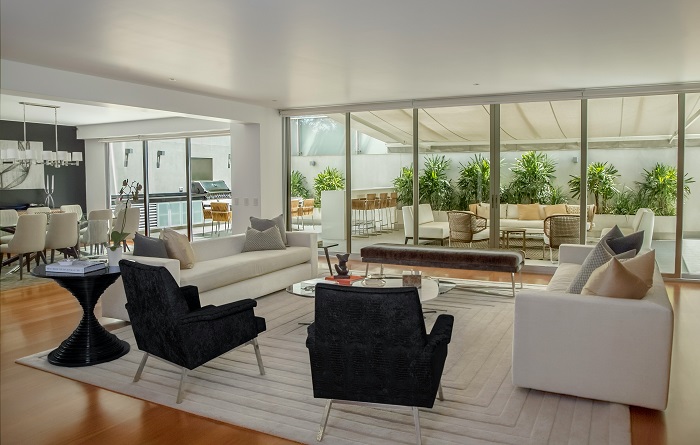Commercial interior design defines the success and efficiency of office spaces in the modern scenario of fast-paced corporate life. An effectively designed office would increase employee productivity and leave a long-lasting impression on clients or partners. In this all-inclusive guide, we will go through the primary rules of commercial interior design for offices that help you achieve functionality and beauty at work.
Understanding the Purpose
Aligning Design with Business Goals
Any commercial interior design enterprise should have a good sense of the core objectives of the particular business at its commencement. Whether creativity, collaboration or simply professionalism is what one wants from an office space, the design should be done in consideration with such goals in view.
Employee Well-being and Productivity
An ideal office would be one which, more to the point, would consider workers’ welfare. Things that influence productivity and job satisfaction in an office most of the time include factors such as good ergonomics, natural lighting, and air quality. This can significantly positively impact the happiness and efficiency of the workforce when done better.
Key Elements of Commercial Interior Design
Space Planning
Effective space planning is the foundation of any successful office design. Strategically placing furniture and workstations for maximum efficiency and comfort, it includes:
● Zoning: the division of an office floor area into various areas, including workstations, meeting rooms, relaxation facilities, etc.
● Flow: Ensure easy movement around the office to reduce interruptions and improve access.
● Flexibility: The ability to configure spaces easily for changing uses.
Lighting Design
Lighting is very essential and central in interior design for commercial purposes. Proper lighting reduces eye strain, improves mood, and enhances productivity. Consider the following:
● Natural Light: The number of windows and skylights shall be maximized to admit as much natural light as possible, which is considered healthy for acceptable health.
● Artificial Lighting: Such ambient, task, and accent lighting combined will provide a perfectly balanced and versatile scheme of illumination.
● Energy Efficiency: Work energy-saving solutions in your infrastructure with energy-efficient lighting, like LED bulbs, that would assist in reducing operational expenses and decreasing the burden on the environment.
Color Scheme
The office color scheme can influence the mood and productivity of the employees. Colors affect people in various ways; for example:
● Blue and Green: Convey serenity and focus.
● Yellow and Orange: These give the mind, like, natural creativity and natural energy.
● Neutral Tones: Convey timelessness and professionalism.
● It’s important to use colors that are appropriate to the company’s brand and culture.
Furniture and Ergonomics
Immense importance lies in investing in good quality and ergonomic furniture to keep employees in good health and comfort. Such factors are discussed below:
● Adjustable Chairs: Ensure appropriate back support via chairs, which should be adjustable according to a person’s requirement.
● Desks: Choose desks that will accommodate different work styles; these should include standing desks to allow workers to move around more.
● Collaborative Furniture: Add comfortable, collaborative seating to achieve desired cubic densities and encourage the teamwork/interaction behaviors critical to collaborative work.
Acoustic Design
Noise is one of the most hazardous factors of distraction in the office. Good acoustic design is essentially a measure for limiting noise pollution and, as such, provides better concentration. The following can affect this:
● Soundproofing: Soundproofing is necessary for better productivity in the office. Buy acoustic wall panels online and hanging them on walls reduces noise problems and gets functionality. Also, use carpets, rugs and curtains.
● White Noise Machines: Use white noise machines to help mask background noise.
● Zoning: Quiet zones can be compression areas for focused work and other separate areas for collaborative activities.
Incorporating Technology
Smart Office Solutions
Integrating technology into office design enhances efficiency and convenience. Consider the following smart solutions:
● Automated Systems: Use automated lighting, climate control, and security systems to streamline operations.
● Connectivity: Ensure robust Wi-Fi and network infrastructure to support seamless connectivity.
● Interactive Tools: Implement interactive whiteboards and video conferencing systems to facilitate communication and collaboration.
Sustainable Design
Sustainability is becoming increasingly important in commercial interior design. Eco-friendly designs not only reduce environmental impact but also appeal to eco-conscious clients and employees. Sustainable practices include:
● Recycled Materials: Use recycled and sustainable materials for furniture and finishes.
● Energy Efficiency: Implement energy-saving measures such as LED lighting and efficient HVAC systems.
● Waste Reduction: Design spaces that facilitate recycling and minimize waste.
Branding and Aesthetics
Reflecting Company Identity
The design of an office should reflect the company’s brand and culture. This can be achieved through:
● Brand Colors and Logos: Incorporate brand colors and logos into the design to reinforce company identity.
● Artwork and Decor: Use artwork and decor that resonate with the company’s values and mission.
● Customized Spaces: Create unique, branded spaces such as themed meeting rooms or lounges.
Creating a Positive Impression
First impressions matter. The design of the reception area and client-facing spaces should create a welcoming and professional atmosphere. Key elements include:
● Reception Desk: A stylish and functional reception desk sets the tone for visitors.
● Waiting Area: Provide comfortable seating and amenities such as magazines and refreshments.
● Signage: Use clear and attractive signage to guide visitors and reinforce branding.
Trends in Commercial Interior Design
Biophilic Design
Biophilic design incorporates some natural elements into the office space to create a sense of well-being, which enhances the creativity of the staff. This includes:
● Add in some indoor plants that will purify the air bringing a certain amount of natural ambiance into the space.
● Natural Materials: Furniture and finishes should be composed of natural materials, such as wood and stones.
● Add water features, like fountains or aquariums, to enhance the atmosphere’s smoothness.
Flexible Workspaces
Modern workspaces are flexible, catering to various diverse clients. The core elements of this would be:
● Hot Desking: Shared workspace or hot desking is a platform that gives the employee freedom to choose the workspace for the day according to the nature of tasks.
● Use modular furniture that can be easily rearranged for various activities.
● Collaboration Zones: Spaces for informal meetings and collaborative work should be provided.
Resimercial Design
In linguistics, resimercial design combines residential and commercial to literally mean a homely, comfortable office environment. The trend includes:
● Cozy Furniture: Put comfortable furniture from the home, like sofas and lounge chairs.
● Warm Lighting: Add some warm lighting and lighten the atmosphere.
● Personalized decor: Allow them to make their space with pictures of loved ones, potted plants, and the flaunting of personal things.
Creating Productive and Aesthetic Office Environments
Effective commercial interior design underpins a productive, comfortable, and aesthetically pleasing working environment. Taking heed of these significant rules would assist any business to arrange spaces so that they do not just stop at functionality but offer great well-being to the employees and include branding.




